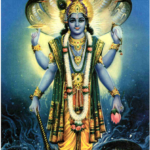Gita 1. 23
yotsyamanan avekse ‘ham
ya ete ‘tra samagatah
dhartarastrasya durbuddher
yuddhe priya-cikirsavah
Meaning – Let me see those who have come here to fight, wishing to please the evil-minded son of Dhritarashtra.
Explanation – Arjuna wanted to see all those who have joined the evil minded Duryodhana to help him fight and usurp the Kingdom rightfully belonging to the Pandavas. Since the war is about to start Arjuna wanted to know with whom he has to fight, who are his friends who have joined the enemy side and who are his real enemies.
In fact this question is a metaphor. Much before the start of the war, everyone knew who are fighting with Pandavas and who have joined Kauravas. Yet, Arjuna wanted to see them as he is confused. This is exactly what happens in our life as we always find it difficult to identify our real enemies and friends. Sometimes what looks good could be bad and vice versa. Certain things that we consume may be enjoyable, but may not be good for health. Junk foods, alcohol, smoking, etc. are enjoyable but certainly not good for health. Whereas medicines or raw vegetables are not enjoyable but certainly very good for maintaining a good health.
Gita 1 (24, 25)
sanjaya uvaca
evam ukto hrsikeso
gudakesena bharata
senayor ubhayor madhye
sthapayitva rathottamam
bhisma-drona-pramukhatah
sarvesam ca mahi-ksitam
uvaca partha pasyaitan
samavetan kurun iti
Meaning – Sanjaya said: O descendant of Bharata, being thus addressed by Arjuna, Lord Krishna drew up the fine chariot in the midst of the armies of both parties.
In the presence of Bhishma, Drona and all other chieftains of the world, Hrsikesa, the Lord, said, just behold, Partha, all the Kuru who are assembled here.
Explanation – In this verse Arjuna is referred to as Gudakesa. Gudaka means sleep, and one who conquers sleep is called gudakesa. Sleep also means ignorance. So Arjuna conquered both sleep and ignorance because of his friendship with Krishna. As Hrsikesa, or the controller of the senses and mind of every living entity, Krishna could understand Arjuna’s purpose in placing the chariot in the midst of the armies.
Again the Lord addressed Arjuna as ‘Partha’, means son of Pritha or Kunti who is the sister of Krishna’s father. This could mean either that ‘Arjuna, no need to worry, as being your close relative, I am there to help you’. Or it could also be that oh, son of Kunti, do not behave like a woman, be brave and start fighting instead of getting confused as you have the necessary knowledge to do what is required.
Why did Krishna position the chariot in front of Bhishma and Drona and not closer to Duryodhana? May be Krishna had a hidden agenda in doing so! If the chariot was placed in front of Duryodhana, may be Arjuna would have been so angry that the war would have started instantly and the world would not have been benefitted with this great philosophical treatise called “Bhagavad Gita”. Also Krishna asked Arjuna to see the ‘Kurus’ who are assembled there and did not say to look at the children of Dhritarashtra who are assembled there. Being a Kuru himself, Arjuna for sure is going to be confused.
Gita 1. 26
tatrapasyat sthitan parthah
pitrn atha pitamahan
acaryan matulan bhratrn
putran pautran sakhims tatha
svasuran suhrdas caiva
senayor ubhayor api
Meaning – There Arjuna could see, within the midst of the armies of both parties, his fathers, grandfathers, teachers, maternal uncles, brothers, sons, grandsons, friends, and also his father-in-law and well-wishers–all present there.
Explanation – When Lord Krishna, told Arjuna to behold the Kuru on the battlefield, Arjuna saw the members of his family, assembled on both sides. He saw Bhurisrava, who was just like his father. He saw his grand-fathers and uncles such as Bhishma and Somadatta etc., preceptors Drona and Kripa etc., maternal uncles, such as Purujit, Kuntibhoja, Salya and Sakuni etc., brothers and cousins- Bhima and Duryodhana etc., sons, such as Abhimanyu, Ghatotkatcha, Laksmana (Duryodhana’s son) etc., grandsons, such as the sons of Laksmana; friends of Duryodhana and Pandavas, named Ashvatthama etc.,; fathers-in- law such as Drupada and Saibya etc., and also well-wishers, such as Satyaki and Kritavarma etc.
Gita 1. 27
tan samiksya sa kaunteyah
sarvan bandhun avasthitan
krpaya parayavisto
visidann idam abravit
Meaning – When the son of Kunti, Arjuna, saw all these different grades of friends and relatives, he became overwhelmed with compassion and spoke thus:
Explanation – After seeing the warriors, who were related to him, through family and learning, on both the sides, Arjuna suddenly developed an attitude of kinship with them because he thought that on both sides there were his kinsmen and they would be killed in the war. In this way it was his family that would be destroyed ‘on either side. The use of the word ‘Kaunteyah’ in addressing Arjuna it indicates that since he is the son of Kunti he is affected by the morality and afflictions of the mundane world. The use of the word ‘kripaya’ signifies that Arjuna was naturally compassionate. By the use of the word ‘paraya’ it is intimated that not only for his own soldiers was he compassionate but for the enemy soldiers as well.
As a warrior and man of action Arjuna realizes the extend of sacrifice the society would be called upon to make in order that his ambition might be fulfilled and Duryodhana’s cruelty avenged. He reaches the highest level of compassion and his words subsequently clearly reflects his thoughts that reaffirms his feelings to avoid bloodshed at any cost including his own life.


Leave a Reply
Want to join the discussion?Feel free to contribute!